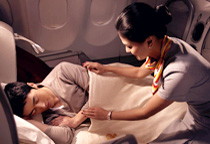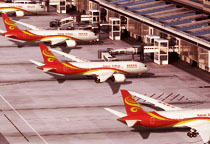Ограничения по провозу багажа

Limits on baggage transportation
A.Prohibited items
Passengers are not allowed to place the following items in their checked baggage or carry them into the passenger cabin; otherwise Hainan Airlines and Grand China Air will refuse to provide transportation services.
I. Firearms and other weapons (including major components), devices capable of firing ammunition (including projectiles and other items) and causing serious personal injury or items that could be mistaken for such devices, mainly including: military guns, official guns, civilian guns, prop guns, firing guns, ball guns, guns outside the country, all kinds of illegally manufactured firearms and simulations of the above items, etc.
II. Dangerous goods, capable of causing serious personal injury or endangering the safety of aircraft and posing a greater danger to the order of transportation, including explosives, gases, flammable liquids, flammable solids, spontaneous combustion substances, substances that release flammable gases in contact with water, oxidizers, organic peroxides, toxic substances, infectious substances, radioactive substances, corrosives and substances and articles not belonging to any of the above categories but dangerous in air transportation. Mainly includes:
- Explosive or incendiary substances and devices or items that could be mistaken for such devices (substances), including ammunition, blasting equipment, pyrotechnic products and simulations of the above items.
- Compressed and liquefied gases, such as hydrogen, methane, ethane, butane, natural gas, ethylene, propylene, acetylene (dissolved in medium), carbon monoxide, liquefied petroleum gas, freon, oxygen (including liquid oxygen devices), carbon dioxide, water gas, lighter fuel and liquefied gas for lighters.
- Spontaneous combustion items, such as yellow phosphorus, white phosphorus, nitrocellulose (including film), oil paper and its products.
- Flammable items in contact with moisture, such as metal potassium, sodium, lithium, calcium carbide (calcium carbide), magnesium and aluminum powder.
- Flammable liquids, such as gasoline, kerosene, diesel, benzene, ethanol (alcohol), acetone, ether, paints, thinners, rosin oil and products containing flammable solvents.
- Flammable solids, such as red phosphorus, flash powder, solid alcohol, celluloid, blowing agent.
- Oxidizing agents and organic peroxides such as potassium permanganate, potassium chlorate, sodium peroxide, potassium peroxide, lead peroxide, peracetic acid, hydrogen peroxide.
- Toxic products, such as cyanide, arsenic, highly toxic pesticides and other highly toxic chemicals.
- Corrosive substances, such as sulfuric acid, hydrochloric acid, nitric acid, sodium hydroxide, potassium hydroxide, mercury (mercury).
- Radioactive materials, such as radioactive isotopes.
- Other items that implicitly contain one or more hazardous materials.
III. Control instruments that have the potential to cause personal injury or pose a significant risk to aviation safety and transport order, mainly including control knives, military and police instruments, and other control instruments as stipulated by the state.
IV. Other articles that have the potential to cause personal injury or pose a significant risk to aviation safety and transport order, mainly including
- Infectious disease pathogens, such as hepatitis B virus, anthrax bacillus, tuberculosis bacillus, and AIDS virus.
- Tinder (including various ignition devices), such as lighters, matches, cigarette lighters, and magnesium rods (flints).
- Power banks and lithium batteries with a lithium content of more than 8 grams or a rated energy of more than 160WH (watt-hours) (lithium batteries used in electric wheelchairs are otherwise regulated).
- Alcoholic beverages with an alcohol volume percentage exceeding 70%.
- Strong magnets, items with a strong, pungent smell or likely to cause panic among passengers, and items of an indeterminate nature with potential danger.
V. Security briefcases, cash boxes, cash bags, and other confidential equipment containing dangerous goods, such as lithium batteries and pyrotechnic devices, are strictly prohibited from being carried on board (except for the confidential equipment that meets the requirements of Article 2.3.2.6 of IATA's Dangerous Goods Regulations).
VI. Irritating or incapacitating devices, such as Mace, pepper spray, etc.
VII. Small gaseous oxygen cylinders (or air cylinders) and liquid oxygen devices for medical use.
VIII. Gun-type electronic dry powder fire extinguisher.
IX. Electroshock weapons (such as Tasers) that contain dangerous goods, such as explosives, compressed gases, and lithium batteries.
X. Matches of any kind (including friction matches and safety matches), lighters (including lighter fuel), and lighters driven by lithium batteries.
XI. Small scooters driven by lithium batteries, such as self-balancing scooters, unicycles, scooters, bicycles, etc., and related accessories.
XII. Self-heating ready-to-eat foods, such as self-heating rice (including instant rice and food heating packs).
XIII. Lithium batteries that may have safety defects, such as discarded lithium batteries, lithium batteries recalled by manufacturers, damaged or swollen lithium batteries, etc. Devices, such as the Samsung Galaxy Note7, are strictly prohibited in carry-on, checked, or hand baggage.
XIV. Avalanche rescue backpacks.
XV. Wild animals and animals with strange characteristics that may pose a risk, such as snakes, wolfdogs, Tibetan mastiffs, etc., do not fall into the scope of small animals and cannot be transported as baggage, except for those handled in compliance with the pet transportation regulations of Hainan Airlines and Grand China Air.
XVI. Articles that Hainan Airlines and Grand China Air consider unsuitable for transportation for the following reasons: dangerousness, lack of safety, packaging, weight, volume, size, shape, and nature of articles, as well as fragile or perishable articles taking into account the aircraft type, etc.
XVII. Other articles prohibited from transportation as stipulated by national laws, administrative regulations, and rules.
XVIII. Articles that are prohibited from exiting, entering, or transiting the People's Republic of China or the countries they pass through according to the laws of these countries.
B. Common special items:
- Items that require personal care should not be checked in or placed in checked baggage. Instead, they should be brought into the cabin as hand baggage. Examples of such items include important documents (contracts and agreements), medications, securities, currency, bills of exchange, jewellery, precious metals and their products, silver products, valuables, antiques, paintings, fragile and perishable items, samples, electronic and digital products, travel documents, medical certificates, X-rays, prescription medications that need to be taken at regular intervals, as well as any other items that require personal attention.
- Regarding liquid items, pleaseclick here to view details.
- Regarding lithium and rechargeable batteries, please refer to the "Lithium Battery Transportation Service" and "Rechargeable Battery Transportation Service" for detailed information.
- Spare batteries (including lithium batteries, nickel-metal hydride batteries and various types of dry batteries) for portable electronic devices, power banks and portable power stations are only permitted in the cabin and are prohibited in checked baggage.
- Precision instruments and electrical appliances, such as DVD players, video recorders, televisions, audio equipment, and other similar items, should be transported as cargo. If they are transported as checked baggage, they must be appropriately packaged.
- The carriage of sports equipment (including starting pistols and their ammunition) as checked baggage requires the prior consent of Hainan Airlines and Grand China Air.
- Certain small animals may be transported as checked baggage,Please click hereto view the specific requirements.
- Diplomatic bags and confidential documents must be carried by the correspondent or diplomatic courier and handled with care. On request, they can be treated as checked baggage.
- Please click here to view the special requirements for folding and electric wheelchairs used by passengers during the flight.
- Sharp or blunt objects other than controlled knives such as kitchen knives, dinner knives, fruit knives, craft knives, scalpels and scissors as well as steel files, iron cones, axes, short rods and hammers must be transported in checked baggage.
- Certain items that are prohibited but pose little risk to flight safety and are urgently needed for normal use may be accepted as carry-on baggage, provided that an appropriate certificate is issued and the items cannot easily be used to hijack an aircraft. For example, if a limited amount of medical supplies or instruments such as alcohol swabs are required to care for a seriously ill passenger seeking medical treatment at their destination, these can be taken into the cabin with the authorisation of the airport, Hainan Airlines or Grand China Air.
- Fruits that emit an unpleasant odour or may disturb other passengers, such as durian and jackfruit, are prohibited from being brought into the cabin. However, they can be placed in checked baggage and securely sealed in cardboard or plastic containers to prevent any odours from escaping.
- Carriage of securely packaged UN 0012 1.4S ammunition (intended solely for use in group sports competitions), camping stoves and fuel containers containing flammable liquid fuel, approved security equipment, non-infectious samples packed with minimal flammable liquids, combustion and fuel cell engines, and osmosis devices is strictly prohibited in the cabin. Check-in procedures can only proceed with our approval.
- Carriage of securely packaged UN 0012 1.4S ammunition (intended solely for use in group sports competitions) and osmosis devices: Please make necessary preparations beforehand and present the certification/MSDS sheets to the airport personnel as evidence of compliance with our regulations.
- Eligible security equipment, chemicals, monitoring devices: Please make necessary preparations beforehand and present the certification/MSDS sheets to the airport personnel as evidence of compliance with our regulations.
- Non-infectious samples packed with minimal flammable liquids: Please make necessary preparations beforehand and present to the airport personnel an appraisal report issued by the Health Commission or a medical unit within China at the county or municipal level or at the same level (e.g., national grade 2A) or above, with official seal (including the date of issuance).
- Regarding dry ice (solid carbon dioxide) for the preservation of fresh and perishable items, passengers are permitted to carry a maximum of 2.5kg with our approval. The package must have vent poles to release the gas. Meanwhile, dry ice (solid carbon dioxide) cannot be transported alone as carry-on or checked baggage. It must be transported alongside the perishable items.
- Aquatic products:
(1) Transport scope
Applicable to domestic flights only.
(2) Transport requirements
When aquatic products are checked in as baggage, each transport package should weigh not more than 30kg, and the dimensional requirements are the same as those for ordinary baggage.
(3) Provisions on aquatic product packages
A. Transport packages for aquatic products must be firm, sealed, odorless, and free from liquid leakage, and must not damage passengers' baggage, or the aircraft's facilities, equipment and other cargoes; they must be able to withstand abrupt changes in temperature and air pressure, and have a certain level of compressive strength so that they will not be damaged during normal air transport.A package must be in the form of a foam box wrapped by a carton. The foam box must have four walls, a bottom and a top. The thickness of the walls should not be less than 2cm, and the body should be free from any damage or crack.The bottom of the foam box should be covered with an absorbent material, such as absorbent paper, absorbent sponge or sawdust.The size of the carton should match that of the foam box, and it is prohibited to put two foam boxes in one carton.Any foam box or carton that is damp, or folded and deformed, or any recycled used foam box or carton should not be used as a transport package for aquatic products.
B. A sealed ice bag or a plastic bottle containing 80% ice can be placed inside the package for preservation.If dry ice is contained, the airline's dry ice transport standard must be complied with.
C. We assume the liability for compensation for aquatic products whose loss is attributed to Hainan Airlines only.
If you have any questions or feedback, kindly contact the 24-hour booking service hotline of Hainan Airlines and Grand China Air at 95339.
C.Checked Baggage Limitations
Checked in baggage shall be packed, locked or tied securely, be able to bear certain pressure, can be safely loaded or unloaded under normal operations, and must be subject to the following rules:
- Travelling cases, bags and handbags shall be locked.
- Two or more bags cannot be tied together as one.
- No other items can be attached to the baggage.
- Bamboo basket, string bag, straw ropes, straw bags and other similar articles cannot be used as a package of baggage.
- Baggage with dangerous markings or tags cannot be used. The dangerous markings or tags shall be removed or covered before the baggage can be used.
- Sawdust, rice husk or grass items cannot be used as padding in the baggage.
- The edges and corners of the hard material outer packaging and the irregular, uneven or sharp protrusions of the packaging surface must be softened, and the soft packing lining materials (such as: foam, sponge, linen, cardboard, bubble film, etc.) must play a protective role in principle to avoid rubbing.
Транспортировка литиевых батарей
Далее приводятся указания по перевозке литиевых батарей в ручной клади, согласно положениям действующей «Технической инструкции по безопасной перевозке опасных грузов по воздуху» ИКАО (применимым к международным и внутренним рейсам):
- Электронное оборудование (часы, калькуляторы, фотоаппараты, мобильные телефоны, ноутбуки, портативные видеокамеры и т.д.) с содержанием лития ≤ 2 г (литий-металлические батареи) и номинальной энергоемкостью ≤ 100 Втч (ватт-час, ионно-литиевые батареи), предназначенное для личного пользования пассажира, разрешается перевозить в качестве зарегистрированного багажа или ручной клади. Если номинальная энергоемкость батареи в устройстве превышает 100 Втч, но не превышает 160 Втч, устройство разрешается перевозить в качестве зарегистрированного багажа или ручной клади с разрешения авиакомпании Hainan Airlines и Grand China Air. При перевозке электронного оборудования в зарегистрированном багаже, необходимо качественно упаковать оборудование во избежание случайного повреждения. Устройство должно быть выключено и защищено от случайного включения.
- Запасные литиевые батареи не подлежат регистрации. Они подлежат провозу только в качестве ручной клади. Запасные литиевые батареи, перевозимые в ручной клади, должны быть защищены от короткого замыкания. Каждая батарея должна быть помещена в специальную коробку или сумку для транспортировки литиевых батарей. Перезаряжаемые аккумуляторные аккумуляторы рассматриваются как запасные литиевые батареи. Пассажиры должны перевозить перезаряжаемые аккумуляторы на борту в соответствии с правилами перевозки запасных литиевых батарей. На борту запрещено заряжать мобильные телефоны и другие электронные устройства с помощью перезаряжаемых аккумуляторов.
- Запасные литиевые батареи для электронных устройств для личного пользования с содержанием лития ≤ 2 г или номинальной энергоемкостью ≤ 100 Втч необходимо перевозить в ручной клади. Запасные литиевые батареи энергоемкостью больше 100 Втч, но меньше или равной 160 Втч, можно перевозить в ручной клади только с разрешения авиакомпаний Hainan Airlines и Grand China Air, в количестве не более 2 штук.
- Инвалидные кресла-коляски или другие средства передвижения или перемещения пассажиров, работающие от ионно-литиевых аккумуляторов, а также портативные медицинские электронные устройства, содержащие литий-металлические или ионно-литиевые элементы питания или аккумуляторы и их запасные батареи, перевозимые пассажирами в медицинских целях, должны перевозиться в соответствии с требованиями транспортировки и упаковки последнего издания «Технической инструкции по безопасной перевозке опасных грузов по воздуху», с разрешения авиакомпаний Hainan Airlines и Grand China Air. Запасные батареи для портативных электронных медицинских устройств с энергоемкостью ≤ 160 Втч или с содержанием лития ≤ 8 г должны провозиться в ручной клади только с разрешения авиакомпаний Hainan Airlines и Grand China Air, в количестве не более 2 штук.
- Запасные литиевые аккумуляторы для электрических инвалидных кресел-колясок или других средств передвижения должны провозиться в ручной клади после получения разрешения авиакомпаний Hainan Airlines и Grand China Air. Для аккумуляторов с номинальной энергоемкостью ≤ 160 Втч, существует ограничение в количестве 2 штуки на человека. Для аккумуляторов с номинальной энергоемкостью больше 160 Втч, но меньше или равной 300 Втч, существует ограничение в количестве 1 штука на человека.
- Смартфоны Samsung Galaxy Note 7, небольшие самобалансирующиеся самокаты с ионно-литиевыми аккумуляторами (по типу: моноклеса, скутеры, гироскутеры и т.д.) и сопутствующие аксессуары запрещены к перевозке в ручной клади и зарегистрированном багаже.
- Запрещены к перевозке портфели, сейфы и мешки для наличных денег и пр., содержащие опасные грузы, такие как литиевые батареи и пиротехнические материалы.
Информация для пассажиров о новых правилах перевозки зарядных устройств для телефона
Уважаемые пассажиры!
Добро пожаловать на рейс Хайнаньских Авиалиний. В соответствии с требованиями Департамента Гражданской Авиации, мы хотели бы напомнить пассажирам, провозящим переносные зарядные устройства, о нижеследующем:
Переносные зарядные устройства в основном используются для подзарядки мобильных телефонов и проч. электронного оборудования; эти зарядные устройства являются внешним мобильным источником питания, который работает от литиевых батареек. В соответствии с действующими постановлениями Международной Организации Гражданской Авиации («Положение о транспортировке опасных грузов воздушным транспортом» и «Положения о транспортировке опасных грузов средствами гражданской авиации в Китае»), пассажиры, которые перевозят с собой переносные зарядные устройства, должны соблюдать следующие правила:
1. Зарядное устройство должнопроносится на рейс только для личных нужд самого пассажира.
2. Пассажир, проходя на бортсамолета, может иметь зарядное устройство при себе, либо же оно может находитсяв его ручной клади, однако поклажа переносныхзарядных устройств в багаж строговоспрещена.
3. Специального разрешенияавиакомпании не требуется в случаях, если номинальная мощность переносногозарядного устройства не превышает 100Wh; если мощностьбольше 100Wh, но меньше 160Wh, то такое устройство можно брать на борт при наличииразрешения со стороны авиаперевозчика, однако один пассажир не должен проносить больше одного такого устройства.
4. Строго воспрещено проносить зарядные устройства, номинальная мощность которых больше 160Wh; также запрещен пронос устройств без видимого указания параметров, а также нельзя проносить и электрические устройства, из подсчета других показателей которых следует, что номинальная мощность больше разрешенной.
5. Во время полета недопускается использование зарядных устройств для подзарядки электроприборов. Вовремя всего полета зарядное устройство всегда должно находится в выключенномсостоянии.
Способ определения номинальной мощности переносногозарядного устройства
Если на переносном зарядном устройстве неуказана номинальная мощность в Wh (Ватт/час),тогда мощность зарядного устройства рассчитывается следующим способом:
1. При заданных номинальном напряжениитока (V) и номинальной емкости (Ah) используется формула:
Wh = V * Ah
По этой формуле высчитывается номинальная мощность. А номинальноенапряжение и номинальная емкость обычно всегда указаны на переносном зарядномустройстве.2. Если на зарядном устройстве указан лишьпоказатель «миллиампер / час» (mAh), тогда поделив эту величинуна 1000 получаем значение в ампер-час.
Пример:
На зарядном устройстве указано, номинальноенапряжение тока (V) = 3,7V, номинальная емкость (Ah) = 760mAh, тогданоминальная мощность высчитывается так:
760 mAh ÷ 1000 = 0.76Ah
3.7V×0.76Ah=2.9Wh
Transportation Services for Powder Articles
I. Tips for Inspection of Powder Articles for Passengers travelling to the United States
Starting from June 30, 2018, the United States has implemented focused inspections on powder articles carried by passengers travelling to the United States. Powder articles with a container volume (single) exceeding 350ml (including) and articles presented in a solid state by compressing powdery materials (such as flour, sugar, coffee, spices, and pastries) cannot be brought into the cabin. If you need to carry such articles, please arrange your trip in advance and check them in at the airport.
The following two types of special powder articles must meet the following requirements if they are to be brought into the cabin.
(1)For powder articles such as medical drugs, infant formula, and cremated remains
Ensure that the packaging is intact and without any signs of damage (including cracks, punctures, etc.). If the packaging is not sealed or displays any signs of damage, ensure that the articles inside the packaging match the description on the packaging.
(2) For powder articles purchased by you at the airport duty-free shops
Ensure that they are sealed in a container or a sealed bag and undergo inspection by airport security personnel.
II. Tips for Inspection of Powder Articles for Outbound Passengers from Australia and New Zealand
Starting from June 30, 2018, Australia and New Zealand have implemented focused inspections on powder articles carried by passengers departing on international flights. Inorganic powder articles with a container volume (single) exceeding 350ml (including) cannot be brought into the cabin. If you need to carry such articles, please arrange your trip in advance and check them in at the airport.
The following two types of special powder articles are exempt from the above regulations. If you need to bring them into the cabin, they must meet the following requirements.
(1) For organic powdery materials, such as medical drugs, infant formula, coffee, protein powder, laxatives (magnesium sulfate), and cremated remains
Ensure that the packaging is intact and without any signs of damage (including cracks, punctures, etc.). If the packaging is not sealed or displays any signs of damage, ensure that the articles inside the packaging match the description on the packaging.
(2) For powder articles purchased by you at the airport duty-free shops
Ensure that they are sealed in a container or a sealed bag and undergo inspection by airport security personnel.





